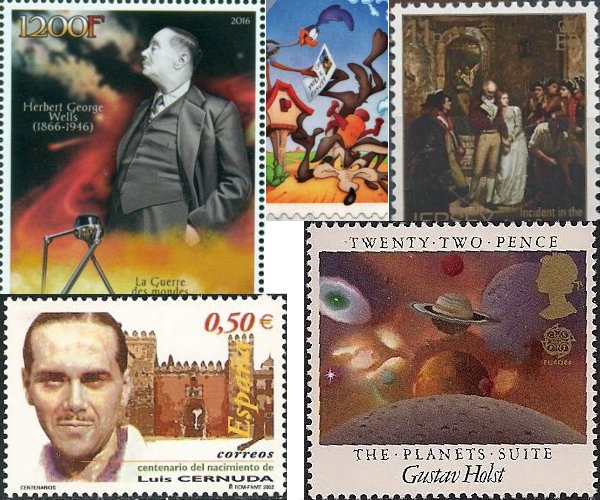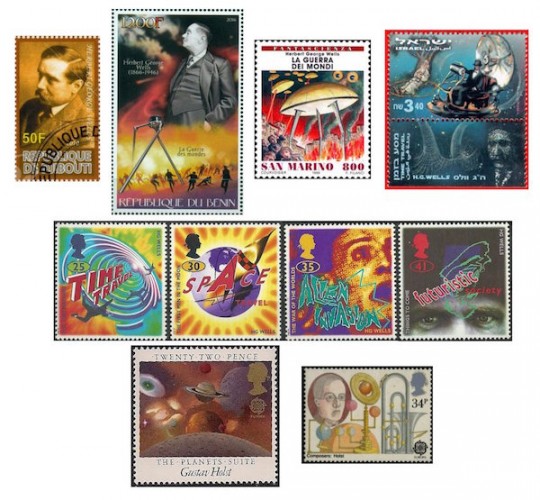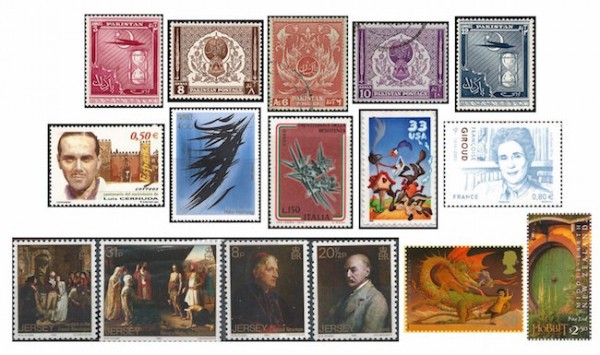The Arts on Stamps of the World — September 21
An Arts Fuse regular feature: the arts on stamps of the world.

By Doug Briscoe
When Caspar Gutman said to Sam Spade, “These are facts, historical facts, not schoolbook history, not Mr. Wells’s history, but history nevertheless,” I thought, someday I must read this Mr. Wells’s history, and so I did. Herbert George “H. G.” Wells (21 September 1866 – 13 August 1946) left us much more than immortal and groundbreaking science fiction, more than The Time Machine (1895), The Invisible Man (1897), and The War of the Worlds (1898), fine as they are: many other novels and short stories and a great deal of nonfiction including the above referenced tome, The Outline of History (1920, with many revised editions). I found it not only highly informative, despite its age, but most diverting. In 2000 an old charge of plagiarism was revisited, with a reexamination of a 1927 lawsuit filed by Florence Deeks (1864–1959), charging that Wells had copied her work. The reevaluation was inconclusive. I don’t want it to be true. There are stamps from Djibouti, Benin and San Marino (both citing The War of the Worlds), and Israel (citing The Time Machine) besides the set of four from Britain, which rather than naming specific works, addresses instead the topics of Wells’s better known fiction.
It happens that one of those topics, space, segues nicely into our next subject, the composer Gustav Holst (1874 – 25 May 1934), whose most popular work, The Planets, is evoked on a stamp issued by the UK in 1985. According to the composer, the suite had more to do with the zodiac than with the solar system, but resistance to that idea has been pretty strong in the century since the suite was composed. The stamp was one of four commemorating pictorial works by British composers. Next to it is an alternate design that was submitted but not approved. On the subject of Holst’s other music, I’d like to draw your attention to a pair of choral pieces with harp accompaniment that he wrote in 1909. These are the Two Eastern Pictures. Very brief, very evocative, different from each other, but both, to my ear, containing captivating and haunting musical ideas. The late, great David Willcocks recorded them for the Unicorn label (with Osian Ellis), as did Stephen Layton for Hyperion/Helios.
Next up is the Pakistani artist Abdur Rahman Chughtai (1894–1975), who inventively synthesized the art of the Mughals with other Islamic art traditions and with Art Nouveau. According to some sources he is considered the national artist of Pakistan. A couple of examples of his work are Arjuna as a Victor and Usha (First Rays of the Morning Sun) (c1967). Besides his paintings, Chughtai designed stamps, coins, and book covers. For the fourth anniversary of Pakistan’s independence in 1951, he created a set of nine stamps that have come to be known as the Chughtai Art set. I show a sample of five.
A solitary and introverted child, Luis Cernuda (September 21, 1902 – November 5, 1963) began writing poetry when he was about 14 and publishing when he was in his twenties. It seems he fully realized he was gay only after accepting a teaching post at Toulouse, but rather than leading to even further withdrawal, it had the opposite effect, resulting in a forthright and declarative stance. His 1931 collection Los placeres prohibidos openly expresses the poet’s homosexuality. By this time Cernuda had been back in Spain for some years, traveling in literary circles. On the publication of a later collection, a celebration dinner was attended by Lorca, Neruda, and others. At the start of the Spanish Civil War Cernuda happened to be lecturing in England, not expecting to be away for more than a matter of weeks, but as things turned out he never returned to his homeland. He passed from Paris to Glasgow and back to England, immersing himself in the atmosphere of both Oxford and Cambridge. Since his youth he’d been a lover of jazz, but now he discovered Mozart. Many years later, his final collection, Desolación de la Quimera (1962), would include a poem dedicated to the Austrian master. His next teaching position was a brief one at Mount Holyoke College, Massachusetts, but the climate did not suit him, and he resettled in Mexico for his remaining years.

Born in Leipzig exactly two years after Cernuda, Hans Hartung (21 September 1904 – 7 December 1989) grew up in an environment of art-lovers and was drawn to painting from an early age. Apprehensive of provincialism, however, he traveled to Italy by bicycle and moved to Paris, with visits to Munich and Dresden. But the antipathy of the Nazis to his Cubist-inclined work drove him to turn his back on his country, and in 1939 he even joined the French Foreign Legion, at one point being arrested by Vichy authorities and held for seven months. On his release he returned to the Legion and lost a leg in the fighting. Awarded the Croix de Guerre, he had his first art show only in 1947. The postage stamp showing his Black Strokes on Blue, influenced by Chinese calligraphy and far removed from the Cubism of his early years, is thus a French one. I was not able to learn a date for the painting, but artexpertswebsite.com gives other samples of his work.
You may already have known, but I didn’t, that the renowned actor Marcello Mastroianni, whose birthday approaches (on the 28th inst.), was the son of a sculptor who has a stamp! Umberto Mastroianni (September 21, 1910– February 25, 1998) studied in the studio of his uncle Domenico, who was a sculptor before him, from the age of 14. Later he studied further in Turin, where he would spend most of the rest of his life. Like Hans Hartung, he took a strong dislike to fascists and joined the Italian resistance during World War II. One of his first post-war pieces was a monument to the partisans. The stamp shows another one he did two decades later, Resistance Fighters of Cuneo (1964-69).
We offer a salute to one of the central figures in American cartoon animation, Chuck Jones (September 21, 1912 – February 22, 2002). He was primarily involved with Warner Bros., and having produced work for Looney Tunes and Merrie Melodies for years, he created the figures of favorite characters Wile E. Coyote and the Road Runner in 1948. They live again on a stamp from the year 2000.
Last year was the centenary of Swiss-born French writer Françoise Giroud (21 September 1916 – 19 January 2003), who was also the editor of Elle magazine from 1946 to 1953. She served in Valéry Giscard d’Estaing’s government from 1974 to 1977, latterly as head of the Ministry of Culture. Giroud was born France Gourdji in Lausanne to Sephardic Turkish Jewish parents. In her twenties she worked on the movie sets of Marcel Pagnol‘s Fanny (1931) and Jean Renoir’s La Grande Illusion. She advanced to the level of screenwriter and also worked as a newspaper columnist and over the course of her life produced some thirty books, some of the later ones being on such varied topics as Marie Curie (1981), Christian Dior (1987), and Alma Mahler (1988). She also reworked the Curie book into a 1991 television series.

British painter Walter William Ouless (1848 – 25 December 1933) was born in Saint Helier on the island of Jersey. His work can be divided into three periods, the early genre pieces, the portraits of his middle years, for which he is best known, and the later landscapes. The stamp set from Jersey eschews the landscapes and gives us one historical picture, M. de Cazotte and His Daughter, and one Biblical, David with the Head of Goliath (in which David looks tebbly tebbly English, what? rahther like Leslie Howard), along with portraits of the celebrated figures of Cardinal Newman (1880) and Thomas Hardy (1922). (This link is to the painting; to see the Arts Fuse item on the stamp, go here.) Ouless also painted a well known portrait of Charles Darwin (1875). Here, too, is a self-portrait from 1918.
It was on this day in 1937 that J. R. R. Tolkien’s fantasy novel The Hobbit was published. I reprise a stamp we used for Tolkien’s birthday and add a newer one from New Zealand giving us Peter Jackson’s idea of Bilbo Baggins’s home in the Shire, Bag End.
A graduate of the University of Massachusetts with a B.A. in English, Doug Briscoe worked in Boston classical music radio, at WCRB, WGBH, and WBUR, for about 25 years, beginning in 1977. He has the curious distinction of having succeeded Robert J. Lurtsema twice, first as host of WGBH’s weekday morning classical music program in 1993, then as host of the weekend program when Robert J.’s health failed in 2000. Doug also wrote liner notes for several of the late Gunther Schuller’s GM Recordings releases as well as program notes for the Boston Classical Orchestra. For the past few years he’s been posting a Facebook “blog” of classical music on stamps of the world, which has now been expanded to encompass all the arts for The Arts Fuse.
